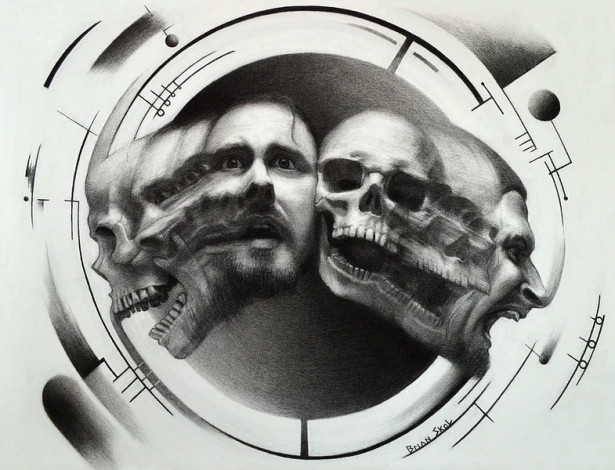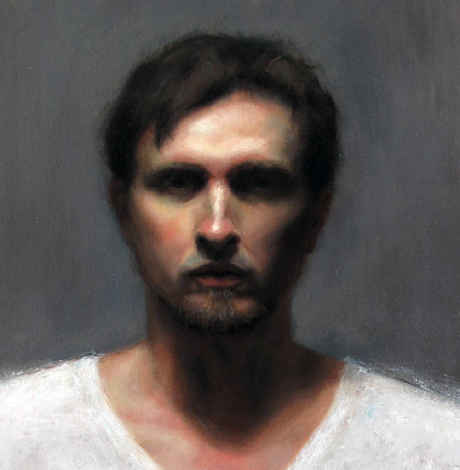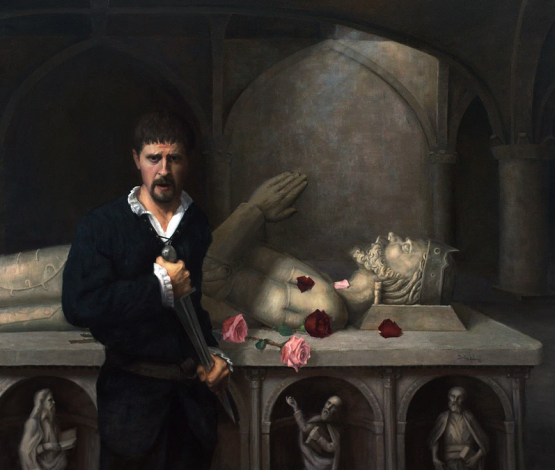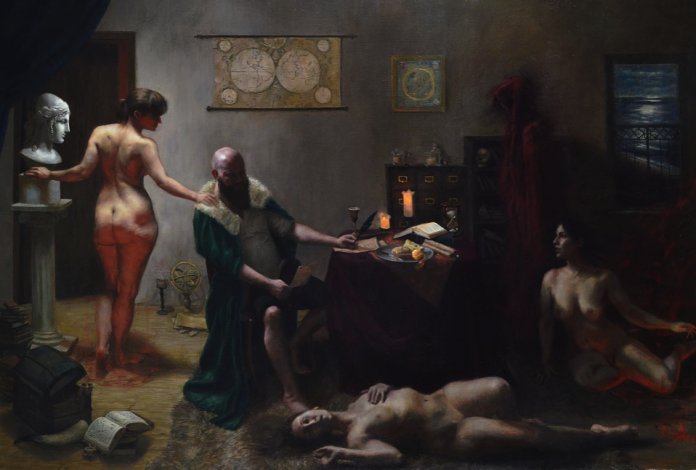Posted on Saturday, October 20, 2018
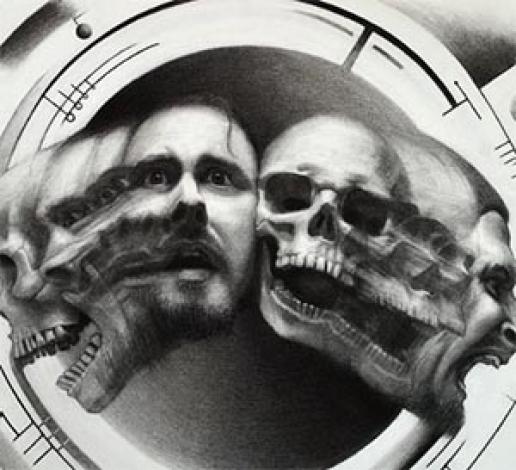
I’m pleased to present the second Studydrawing.com artist interview. This time with my friend, artist, and teacher, Brian Skol. Brian and I never studied at the same place at the same time, but we know many of the same people and our paths crossed many times in Chicago. In the interview that follows, we discuss drawing, learning to draw and improving. We also get into Brian’s history painting and how drawing and painting work together. Enjoy!
Ben: Thank you, Brian, for chatting with me. Can you tell me about your background as an artist?
Brian: Yes, my background is one of those things where my first memories, as a child, involve drawing. So for me it goes all the way back to being a little kid, and all through school trying to get out of as many assignments as I could by playing the art card. So it's always been a part of my life and something I've wanted to do, but I didn't get serious about it until about seventeen or eighteen years old. At that time I was living in Rockford, IL and I was going at it alone and trying to figure it out myself. I soon realized going it alone just was not going to work. I had dropped out of high school because that whole system of education just wasn't working for me. So I had to get a G.E.D. After that I jumped into college because it was the only place, at the time, to be around any kind of art education. That's what led me back to Chicago, because I had grown up just outside of O’hare and then moved to Rockford. I realized I couldn’t do it in Rockford so I went off to Chicago.
Ben: What was the sequence of the places you studied in Rockford and Chicago?
Brian: It was a number of years at Rock Valley College and then Rockford College and then from there I went to the American Academy of Art. But before I went to the American Academy, I took a workshop with Grigor at the School of Representational Art (SORA.) That workshop just lit a fire under me and I said, okay, I’ve got to get to the city and be a part of the art community there. When I got to the city I did a number of things. I went to the American Academy and while I was going to the Academy, I was also going to the Palette and Chisel Art Academy. I met Natanya Rubin, who was an art model at the time, at an after-class modeling session held at the American Academy. No one showed up but me. So I had free reign to draw and have a model. They provided a model for kids to show up and practice and she was one of the models for a couple of the sessions. We got to talking and she told me about the Ravenswood Atelier. So Natanya indirectly introduced me to Matthew and Magdalena Almy. I hunted them down and made the jump from the Academy and Palette & Chisel to the Ravenswood Atelier.
Ben: How many how many years were you at the American Academy and the Ravenswood Atelier?
Brian: I studied in college for about seven years and then I did, between the Ravenswood and studying in smaller schools it was another four years. Too much school! (chuckle) I was determined to get an education. If I couldn't find it where I was at, I left, that's really all there was to it. I studied other things along the way which have proven more valuable to me later on, but at the time I had wanted to learn a certain set of skills and as soon as I wasn’t getting anywhere I would leave. But the different perspectives on method were really valuable. You can't see it until after the fact, and you look back.
In Rockford, it was more conceptual and very postmodern. It was very abstract and there were a lot of garbage teachers, and bad advice. But again, the conceptual, the abstract things have their uses. So I ended up benefiting later on down the road. I don't regret it, but it was a hell of a long path to take.
Ben: How about your teaching?
Brian: I've been teaching for four years regularly. And then before that it was more sporadic with private instruction. As far as being a consistent thing it’s been about a good solid four years.I did a bit of the student teaching at the Ravenswood in the evenings too, but since moving to Michigan I’ve taught at the Ann Arbor Art Center and then the Birmingham Bloomfield Art Center, as well as a lot more private instruction. The teaching has ranged from Plein-air teaching, drawing, anatomy, and painting.
Ben: Looking at the totality of your education journey, or the time you’ve spent teaching, what would you say was your most significant experience in learning to draw? What period of instruction, teacher, or set of ideas helped you make the most progress towards your goals?
Brian: If I had to pin it down it was two instances. I had the long hard road all the way up to attending the Ravenswood Atelier. For a number of years, I was trying to go it alone and trying to piece things together with what I could read versus what I could get from teachers. That was really slow progress, but it laid the groundwork for exploring all of these other methods, except for the sight-size method, which I would learn at the Ravenswood Atelier.
When I got to the Ravenswood, that was probably the fastest in my life that I’ve progressed. If you had seen the drawing I did right before starting, compared to the drawing that I did three months later at the Ravenswood, you would not think it was the same artist. It was like night and day. I just hit the ground running because it was the final puzzle piece as far as putting everything else together that I had learned. Everything up to that point was preparation for this, and this was the icing on the cake. Here was the sight-size method, an exacting method where you can really fine-tune and really hone your drawing. And I just I just took to it. I was like, alright, this is the missing piece that I've been looking for. I loved it. So that was the first significant experience.
"You realize after finishing studying, you've really just begun."
The second was after I decided to leave the Ravenswood Atelier and I jumped into the first painting project I did after school. It was my painting on Shakespeare and Hamlet. What I came to realize was that I’d gotten all this education under my belt, but what could I do with all of it? You realize after finishing studying, you’ve really just begun. You really are just starting out in your own understanding of how to take these methods and apply them to an even bigger picture or project. So that painting was six months of hell. It was like six months of me believing “I'm ready to make paintings…” and having reality hit me, and realizing my desires did not match my skill set. But the difference, this time, was that I had an understanding of how to get those skills. But it wasn't like I was completely in the dark, it was like, all right, now I have a few different ways to think about things and I can apply them to solve these new puzzles. So those two instances were where I had the biggest difference between where I was before I started, versus shortly after.
Ben: So what was the hardest part of that second experience?
Brian: The hardest part was where the theory meets the application. I worked in construction for a while, and one of the things I would come across from time to time was when you’re working off blueprints, and you come to find out really quickly whether or not the architect has ever picked up a hammer before. You can tell if they've never picked up a hammer if the designs just don’t align to reality, as in, you know that physics just doesn't work like that so you have to make adjustments on your own.
An idea for a composition or a painting is similar. You have an idea and try to draw it out, and you see if it survives reality or actually makes for a good drawing. You can have an idea and the idea relies on multiple perspectives, but you can’t make one work or it only works with multiple perspectives.
So for that second experience with my Hamlet painting, it was the conflict between what I want to paint, versus what I’m capable of doing. There are also problems to solve that you don’t even know exist until somebody points them out. There are others you just don't know how to solve yet, because your skills aren’t there. So that experience was the process of bridging that gap between what I want to paint and what I can actually paint.
Ben: I remember an aspect of this on my own projects. It’s one thing to sketch something out on an 8x12 or normal sized sheet of paper, but when you enlarge it and draw a version of it the same size as a full-size painting, it’s a different animal.
Brian: Oh, it’s a completely different animal. Even then, when you sketch something out, even that's not enough to tell you whether or not it works. There's this allure of the sketch. Delacroix talks about it all the time, the allure of the unfinished. Some things work like that, as a sketch. But then you think you’ve nailed down the idea so you go to see it through, once drawn out at full size you could realize it only works as a sketch.
Ben: Has the process of teaching changed anything about your understanding of drawing and the process of learning to draw?
Brian: Yes, very much so. There’s that old adage: “...people who can’t, teach.” I think that’s just complete b.s. And it says more about the person who says it than anything else. I think if you take teaching seriously, it forces you to really be on your game. So when I got the teaching job at the Ann Arbor Art Center, I sat down and really asked myself “how much can I articulate?” I also asked myself what I really knew well enough to demo, with people watching me, and getting blasted with questions. Suddenly I realized that there is “good” in terms of drawing and painting, but “good” in terms of teaching is a whole different demon. So I spent a lot of time trying to tighten up and figuring out how to distill what I knew to be able to explain it.
One of the major things that I wanted to get across was explained so much better by a guy named Iain McGilchrist. He was talking about how the brain identifies things and said there is no such thing as things (to the brain), there are only patterns. Harold Speed talks about this as well. It’s an innate sense we develop, over time, from childhood into an understanding of how we see the world. Speed said that we don’t see things, we feel them. For example, how do you know the difference between whether or not the piece of concrete you see is hard and a pillow that you see is soft? Most people don't even think about it they just know, automatically by sight, but it’s because they feel it as they look at it. All they see are patterns of light and dark and patterns of color and texture. These patterns, working together, reveals to us what the thing is.
"Step one...go out and live your life..."
Another thing I knew I wanted to get across started at a Comic-Con I went to a couple years ago. I saw an interview with Frank Miller, such a cool guy, and he was he was up there with Stan Lee. It was hilarious. They were up there and just giving each other shit the whole time, back and forth. Miller, in his abrupt manner, said “before anybody asks me I'm just going to stay it. I always get these questions ‘what do I need to do to be a good artist?’, ‘what do I need to do to improve myself?’” He said: “Step one...go out and live your life. You have to have some reason to be an artist. Second, figure out how shit works. Figure out how things work, and if you can't figure it out, invent it.”
This really got me thinking. I realized that, one day, when I have my own school and my own drawing program, the first thing I'm going to have students do is build the thing they draw, first. Because, you have to have a working knowledge of making things look as though they work (in terms of the patterns of light, dark and color), or at least, you have to be able to fake it.
So I could talk about the processes of art all day long, but if I could distill it down, it's really all about learning to see, seeing patterns, and make things work by trying to reproduce those patterns.
Ben: In my schooling we kicked around the term ‘abstract shapes’ and the idea that when you are drawing and painting, in your mind, you are turning what you see into abstract shapes and you translate those abstract shapes into the shapes that you draw or paint. This is especially important when it comes to like things that there is no way to draw or paint directly, such as a metallic surface. For example, in drawing or painting something made of brass or gold, you have to translate that into these abstract shapes or patterns that you put down on your work, and the viewer’s mind puts these back together and that's what becomes the ‘feel’ or visual impression of the subject.
Brian: Metal and metallic surfaces are something I talk about frequently. I say to my students, “when you’re looking at the world normally, you can tell the difference, with your eyes, between something that's metal versus something that is wet.” But if you look at the visual patterns that make an object appear wet, compared to the patterns that make an object look metallic, they are very close to one another. It's just the relationship of those patterns that are off. They're different and sometimes very slightly. The metal example has always been a go-to example for myself, to illustrate just exactly that you really have to forget about the object itself. You have to forget about the thing itself and focus on the shapes and patterns if you care about getting a proper representation.
Ben: Do you introduce this concept early on to your students, even in in your beginning drawing classes?
Brian: Yes. Because I think that learning to draw is really just learning how to think about things in a specific way. It's problem-solving. So I feel that understanding what we’ve mentioned: breaking what you see into shapes and patterns, or seeing values, or connecting your art to things to your personal life, or your personal experiences....that is all just teaching problem-solving in a creative way.
It’s one thing to just simply get good at copying an object. And “copy” isn't the right word. It's one thing to get good at accurately representing an object. It's another thing to give me a reason to look at it, and a reason why I should I look at it right now. We don't look at Raphael simply because he was able to accurately represent things in nature. It’s not just about the ‘representing’ but all the other elements, and all of that that is problem-solving and creatively looking at something.
What I admire about the Russian School is that one of the first principles that they talk about, as far as drawing goes, is to get an idea of what you want to do before you do it. Have some sort of motivation for creating this image. Which means imbuing it with some kind of character, or some kind of feeling that you want to convey. So, in a teaching context, it’s always tricky. How much do you throw out at new students? I think there's got to be a balance between an approach that's really stringent and precise versus an approach that relaxes the stringency a bit and allows more creative thought to seep in. People are going to leave and they’re not going to want to learn from you if you’re just one thing.
Ben: What is the worst advice about drawing that you’ve heard? Are there any ideas about drawing that you've encountered that you think derail a student, or throw them off-course, or are generally counterproductive?
Brian: Yeah, two things. First, the idea that practice makes perfect is something that people distort into believing that as long as they show up, they're going to get better. I've run into this before. I've been in and taught classes with people who have just been showing up for the last twenty years and not making much progress. They just practice making the same mistakes over and over again.
"What scares you the most?"
So people ask me “how do I improve my art?” My simplest question to them is “what scares you the most?” That's how you know where you need to improve. It’s very uncomfortable and you have to tackle the thing you're the most afraid of, that you know you're not good at, and you have to figure it out. That's where practice makes perfect. Practice only makes perfect if you're in unknown territory, and practicing with a purpose.
Another counterproductive idea would be not wrapping your head around the big picture. You see this with portraiture and you see some professionals doing this. They say “I'm going to start at the eyes and I'm gonna gradually work my way out” It feels good to do, and feels like you get results really quickly. If all you want to do as an artist is portraits, that's fine. Do it that way. If you have any hopes of doing anything more, stay away from that message like it's the plague. You've got to wrap your brain around seeing the whole head if you're going to be a proper portraitist. If you try to go any further with your painting from there it only gets more challenging. Nobody comes up with a grand composition in painting and starts with the belt buckle and works out from there. Well trained artists learn to stay focused on the whole picture.
So I think it’s best to be well rounded, which is probably the hardest and takes the longest, but I've always advocated a well rounded approach where you can do things more than just one way. If you can do that, you're in a good spot because you can always go back to the sight-size method, which is great for fine tuning. But If you depend on the sight-size method for everything, what if you're in a situation where you can't line things up and use sight-size? You’re screwed.
Ben: What do you tell your students to focus on and practice to get the most bang for the buck for the time and effort learning to draw or improve their drawing?
Brian: I think it's to run schizophrenically back and forth between strict and rigid observation and learning how to work out of your imagination. You have to develop both. I would say it would be helpful to develop both at the same time if you can. When I personally spent a lot of time working from my imagination, and then went back to working from nature, it was a relief. It felt easy at first. But when you spend time working from nature and dig into its intricacy, it becomes hard again, and switching back to working from imagination then feels like a relief, and it starts all over again.
Another thing I would say about getting the most out of your time, is to know that there is a time and place to not listen to your teacher. It’s tricky because when you are under the guidance of a teacher, you want to listen, and there’s a lot of time to listen to your teacher. But that time is also a perfect opportunity to experiment. Because when you mess up, you have to have someone there to help you deconstruct why you messed up. And that’s the most important thing, to try something, and experiment, and if it works out you learn something, and if it doesn’t work out, you still learn something. But more so, if it doesn’t work out, you may not know why, and that is where a teacher can step in and shed some light on the problem. Also, sometimes people don’t even know what they are doing that’s right. With my students, depending on what they are doing, I try to point out the parts of the drawing that really worked and ask “go back to when you were doing this part...what were you doing?”
Ben: Or you’re like me and really challenge your teachers by taking apart everything they are telling you, and end up annoying them.
Brian: Hahah...well that’s another aspect of teaching that I personally really love, because you can prepare all day long, but nothing prepares you for that random question from that random student, who may not be trying to be annoying about it, but hits a weak spot in your knowledge. It it keeps you on your toes.
Ben: What motivates you as an artist?
Brian: I just have a want to learn, and I'm in it for the challenge. I’m in it for the puzzle. I’m in it to see what I can do. As soon as I'm done with a painting, I forget about it. All I care about is the challenge. I don't care about the thing, once it's done. It's the figuring it out that motivates me.
There’s that criticism that people have when they see abstract art...they say “my kid can do that.” The point of that statement is not about the person’s kid, but that anybody could make something like that. I think humans have an innate appreciation for something that has been done, that is beyond their own skill set, beyond their comprehension, and beyond their personal ability. So when you see great art, it says “this is what humans can do, this is what’s possible.” This is what achievement looks like.
"This is what painting can be. This is what can be achieved.”
I was in Milwaukee a long time ago, and I was just starting to go to college. I saw Bouguereau’s Homer at the Milwaukee Art Museum. I cried in front of that painting. I stood in front of that painting for an hour, contemplating how it was that I didn't know a human was capable of doing something like this. The whole thing was a smack in the face, and it said to me “This is what painting can be. This is what can be achieved.” So that's really my motivation. What can I achieve? What can I express? And how successful can that expression be? Can I convey what I want to say? Can I do that and tell a story and give people something to enjoy?
Also, I feel like the most rewarding thing for me is this: Making a painting, showing it, and then having somebody come up to me and unload their entire life story because I moved them. Some artists don't want to hear it. Some artists have told me they think it's a burden. Well, I say it’s a burden that you should bear if you're going to get into this seriously, because that's how you know you've done it right. That person feels an intimate connection with a picture that you made, and now you’re this conduit, or like a visual therapist in some ways.
